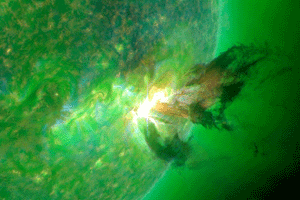Over the past few months, however, we've been able to show our visitors the captivating signs of increasing solar magnetic activity, in the form of complex clusters of sunspots approaching the size of planet Jupiter, stunning luminous prominences of magnetically sculpted gases in the Sun's atmosphere, and, most spectacular of all, solar flare and CME events, of increasing magnitude and multiplicity.
The eruption shown in the video happened on June 7th. It starts with a medium strength flare. A flare occurs when a large amount of energy stored up in intensely twisted magnetic fields reaches a breaking point, the magnetic fields able to twist no further--not unlike how a rubber band can be twisted and wound tighter and tighter, but only to a point (often a sharply painful point, if you're the one doing the winding). The magnetic fields "break down" and reconnect in a more relaxed configuration, imparting their energy to the surrounding gases of the Sun's atmosphere, which heat up to as much as 20 million degrees (Kelvin or Celsius, take your pick; at these temperatures the difference is negligible). The result is an explosion with far greater punch than a hydrogen bomb.
As sunspots are located at places where strong magnetic fields emerge from the Sun, they mark regions of strong activity--"active regions"--and are generally the places to look to in anticipation of solar flares. Those same magnetic fields that form the sunspots are the ones that will break out as a flare if they become too intensely twisted.
Following the modest sized flare of June 7th, a somewhat more-than-modest-sized CME took place. CME's are often triggered by flares--another reason that active regions on the Sun are the places to keep your eyes on! A CME can be thought of as a popping water balloon. In a water balloon, a mass of water is contained within the tense membrane of the balloon rubber. The tension of the rubber contains and shapes the water--until the balloon pops. You know what happens then.
On the Sun, magnetic fields that emerge from one magnetic region, arcing around to a neighboring region of opposite polarity to form a closed loop, act upon the hot, electrically charged gases (plasma) of the Sun's atmosphere much as the balloon membrane acts upon the water inside: the gases are "bottled up" and confined. And on the Sun, we're not talking about an ounce or two of water inside that balloon; we're looking at billions of tons of hydrogen and helium plasma!
So when that balloon pops, we get quite a show: all those billions of tons of plasma bursting away from the Sun at up to a million miles per hour. Why does the balloon pop? "Simple." When the magnetic field loops that contain the plasma break down and reconfigure to a more relaxed state--which is the solar flare part of the equation--those loops and arcs of confining force break down and all that plasma is released.
The June 7 CME was among the largest I recall seeing, but with the Sun's activity heating up, I expect we may see more of this--certainly we're in for a lot of "normal" flare and CME activity as we approach the next solar maximum, expected to peak sometime in 2012 or 2013. Come up to Chabot and we'll give you a look.
 SDO image of June 7 CME. Credit: NASA/SDO
SDO image of June 7 CME. Credit: NASA/SDO